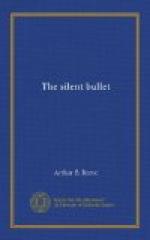“It seems to me, Walter,” he exclaimed in disgust, “that this mystery is considered insoluble for the very reason which should make it easy to solve—the extraordinary character of its features.”
Inasmuch as he had opened the subject, I laid down the letter I was reading. “I’ll wager I can tell you just why you made that remark, Craig,” I ventured. “You’re reading up on that Wainwright-Templeton affair.”
“You are on the road to becoming a detective yourself, Walter,” he answered with a touch of sarcasm. “Your ability to add two units to two other units and obtain four units is almost worthy of Inspector O’Connor. You are right and within a quarter of an hour the district attorney of Westchester County will be here. He telephoned me this afternoon and sent an assistant with this mass of dope. I suppose he’ll want it back,” he added, fishing the newspapers out of the basket again. “But, with all due respect to your profession, I’ll say that no one would ever get on speaking terms with the solution of this case if he had to depend solely on the newspaper writers.”
“No?” I queried, rather nettled at his tone.
“No,” he repeated emphatically. “Here one of the most popular girls in the fashionable suburb of Williston, and one of the leading younger members of the bar in New York, engaged to be married, are found dead in the library of the girl’s home the day before the ceremony. And now, a week later, no one knows whether it was an accident due to the fumes from the antique charcoal-brazier, or whether it was a double suicide, or suicide and murder, or a double murder, or—or—why, the experts haven’t even been able to agree on whether they have discovered poison or not,” he continued, growing as excited as the city editor did over my first attempt as a cub reporter.
“They haven’t agreed on anything except that on the eve of what was, presumably, to have been the happiest day of their lives two of the best known members of the younger set are found dead, while absolutely no one, as far as is known, can be proved to have been near them within the time necessary to murder them. No wonder the coroner says it is simply a case of asphyxiation. No wonder the district attorney is at his wits’ end. You fellows have hounded them with your hypotheses until they can’t see the facts straight. You suggest one solution and before-”
The door-bell sounded insistently, and without waiting for an answer a tall, spare, loose-jointed individual stalked in and laid a green bag on the table.
“Good evening, Professor Kennedy,” he began brusquely. “I am District Attorney Whitney, of Westchester. I see you have been reading up on the case. Quite right.”
“Quite wrong,” answered Craig. “Let me introduce my friend, Mr. Jameson, of the Star. Sit down. Jameson knows what I think of the way the newspapers have handled this case. I was about to tell him as you came in that I intended to disregard everything that had been printed, to start out with you as if it were a fresh subject and get the facts at first hand. Let’s get right down to business. First tell us just how it was that Miss Wainwright and Mr. Templeton were discovered and by whom.”




